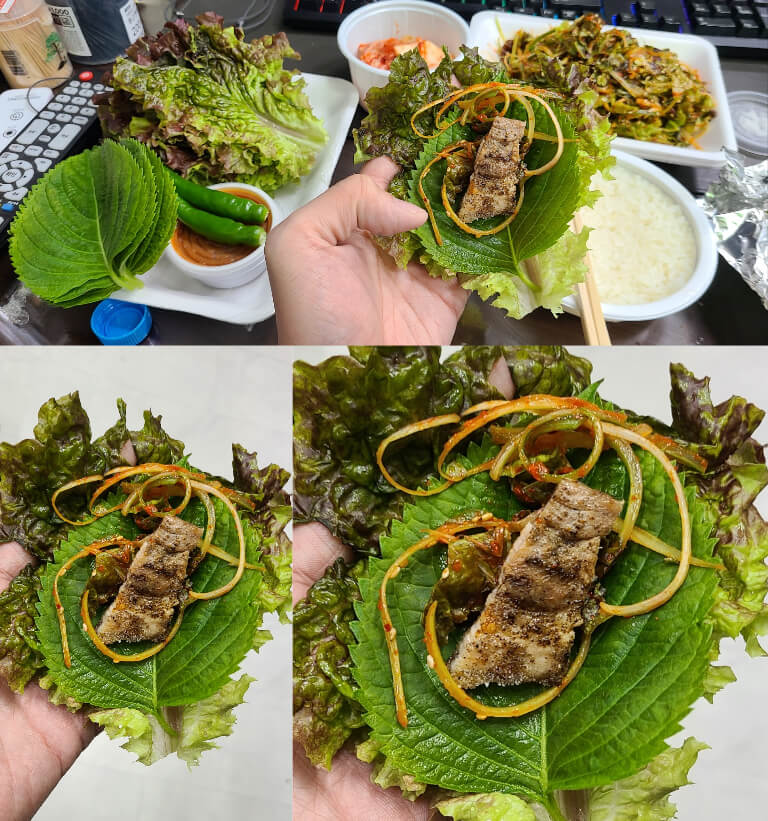It is often on the table. That is perilla leaves. Today I would like to talk about perilla. We’ll learn about how the seeds are used in a common Korean expression, the oil extracted from them, the properties of easy-to-grow perilla, and about the benefits of perilla leaves, which are used as wraps when eating Korean barbecue.
Sesame/perilla seeds are pouring out.
In Korea, when we see a married couple or lovers who seem very happy together and overflowing with love, we often say, “Sesame/perilla seeds are pouring out.” Non-Koreans are sure to ask what you’re talking about when they hear this expression for the first time. In Korea, sesame seeds and perilla seeds are collectively called ‘ggae’ and we often don’t differentiate between them. I guess we use that expression because perilla and sesame seeds are so tiny but so full of flavor. Sesame and perilla seeds are a flavor enhancer that features very often in Korean food.
A good enhancer in the world. Sesame oil, perilla oil
Personally, sesame oil is my favorite flavor enhancer in the world. Sesame oil is the oil produced by pressing sesame seeds. Sesame leaves aren’t eaten, but perilla leaves are. So Korean people sometimes call perilla leaves ggae leaves. Sesame leaves are thick, tough, and strong, so I think they would be difficult to eat. If you want to try it, you might be mistaken for an herbivore.
But anyway, today we are learning about perilla. The oil produced by pressing perilla seeds is called perilla oil, and it is another great flavor enhancer that I personally love.
How to eat. Wrap with perilla leaf
In a previous post, I mentioned that perilla leaves are often a part of Korean barbecue parties. Just as Koreans like to eat barbecued pork belly wrapped in lettuce, they also like to eat barbecued pork belly wrapped in perilla leaves. Gluttons who want both at once place a perilla leaf on top of a piece of lettuce, and then put a piece of pork belly on top and wrap it up. Then, they spread ssamjang on it and open their mouths as wide as possible to fit it all in. In Korean food, where there’s meat, there are always vegetables to accompany it.
[The following is a photo of a wrap with 1 perilla leaf and 1 piece of lettuce]

Perilla leaves can be added to the green onion salad mentioned in a previous post to make it even tastier, and it can also be added to stews for a beautiful flavor and aroma. But don’t just add it to everything. There are soups and stews that it doesn’t go well with. For example, perilla leaves in seaweed soup are a big no-no!, while perilla leaves in soybean paste stew are A-OK!
Korean seaweed (Feat. perilla oil)
Ah! Everyone’s favorite Korean seaweed also has perilla oil on it too. Some brands use sesame oil instead. It’s really up to personal preference. I suggest you try comparing the taste of seaweed with perilla oil to that with sesame oil. Then you can really understand the difference between sesame oil and perilla oil. Oh, of course, if you keep 1 bottle of sesame oil and 1 bottle of perilla oil in your fridge at home, they’ll be perfect for making and enjoying Korean cuisine.
The benefits of perilla leaves
Perilla leaves are high in iron and can help stop anemia. Popeye the Sailor supposedly ate spinach because the iron in it helped make him strong, but I’d recommend that Popeye gives perilla leaves a try. Perilla leaves are known to contain 2 to 3 times as much iron as spinach. They also have a component called luteolin, which is known to relieve inflammation and allergy symptoms, and is good for coughing, runny nose, and sneezing. They are also said to be effective in fighting off cancer and strengthening the immune system.
My own personal perilla field
When I lived on the first floor of an old apartment, I tried planting some perilla seeds in the garden, and they just grew by themselves without any extra effort on my part. I just watered them every once in a while. And the next year, even more of them grew all over my garden, turning it into my own personal perilla field. Perilla is probably the easiest vegetable to grow at home in your garden. It’s very hardy and grows easily.
Barbecue some pork belly, wrap it in perilla leaves, spread some ssamjang, and take a bite! It’s what’s for dinner!
Extra something special, lettuce
Lettuce adds that extra something special! You can buy lettuce at any supermarket. It doesn’t have to be the red lettuce or endive that we eat in Korea. Romaine lettuce and butter lettuce are also good. Anything works as long as long as it can wrap that pork belly up nice and cozy.